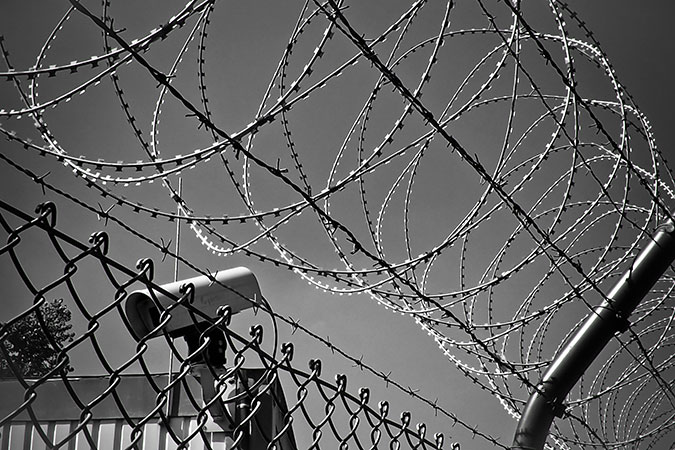
History of Security & Policing
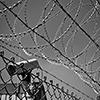
Since its inception in the United States, technology, corruption, crime and scandals have contributed to the evolution and progression of security and policing across the country. While local communities and federal departments haven’t always been equipped to handle these discrepancies, many centuries of revolutionary reform have changed the way America views and interacts withthe security of our law enforcement.
Before Police Departments
 Before and after the War of Independence, policing occurred in local communities. During this time, policing in America was an informal, evolved form of the safety and security system in England. What is known today as a police officer was once referred to as a night watchman. Night watchmen were responsible for warning the community in the event of an emergency such as an attack or a fire. They used wooden rattles and blow whistles to bring attention to threats while enforcing curfews and looking for suspicious activity after dark.
Before and after the War of Independence, policing occurred in local communities. During this time, policing in America was an informal, evolved form of the safety and security system in England. What is known today as a police officer was once referred to as a night watchman. Night watchmen were responsible for warning the community in the event of an emergency such as an attack or a fire. They used wooden rattles and blow whistles to bring attention to threats while enforcing curfews and looking for suspicious activity after dark.
Night watchmen, sometimes referred to as petty thieves looking to avoid military conscription, were soon joined by constables. Constables were a professional force often charged with overseeing the night watchmen. The responsibility of the constables went far beyond providing security for their communities. They also performed civic duties such as surveying land, overseeing sanitation, and, in some lightly populated areas, collecting taxes. Constables were either paid "per job" or by commission.
In the south, policing took an entirely different approach. During this time, communities had issues with crime and escaped slaves and insurrections. As a result, the slave patrol was formed. In 1704, the first slave patrols were formed in North Carolina and quickly spread throughout the South. Some slave patrols grew to massive numbers and were highly organized.
As time progressed, the United States would also see the formation of its first federal law enforcement agency. President George Washington signed the Judiciary Act in September 1789. This act, amongst other things, founded the U.S. Marshals. Marshals were not only responsible for enforcing the law, but they were also given the power to enforce the will of federal judges. During the nineteenth century, the marshals served as the only source of law enforcement and security in the West.
Centralized Policing
 The end of the 1700s introduced a wave of people moving to cities. By 1870, one in four Americans lived in large cities like New York, Philadelphia, and Cincinnati. It eventually became apparent that the old system of night watchmen managed by constables would no longer be sufficient to meet this new challenge.
The end of the 1700s introduced a wave of people moving to cities. By 1870, one in four Americans lived in large cities like New York, Philadelphia, and Cincinnati. It eventually became apparent that the old system of night watchmen managed by constables would no longer be sufficient to meet this new challenge.
Many immigrants from Europe also added to the massive city populations. With immigration came ethnic tensions that eventually exploded into violence. It wasn’t uncommon for angry mobs to attack immigrant and African American communities. Riots would go on for days that resulted in destruction and death. Constables and night watchmen were rendered powerless and the rioting only stopped when the state militia was called in.
As a result, the first centralized police departments were formed to deal with the unrest in the big cities. First, the Day Police were created in 1838 (later to be replaced by the Boston Police Department in 1854), followed by New York City in 1845, Chicago in 1851, and Philadelphia in 1855. It wouldn’t be long before every major city had a centralized police station. The new centralized police force differed from the night watchmen and constables. Not only were the new police force paid as full-time employees, but they proactively went out on patrols to prevent crimes and provide security for the community.
The old system was reactive in nature. The issue was that night watchmen and constables typically didn’t respond to a situation unless someone reported a crime. Now that police officers were actively responding to and preventing crimes, policing and subsequently security once more underwent a significant evolution.
Reformation
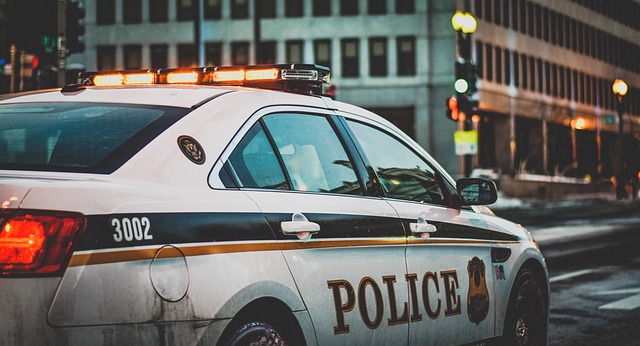 As the nineteenth century came to an end, the call for an end to political corruption led to various reforms, sweeping police organizations under many investigations. Allegations of corruption within the police force ran wild. As a response, police departments began to employ more mid-ranking officers, strengthening their chain of command. The police force began to evolve once more as centralized special units, such as gambling and narcotics units, were born.
As the nineteenth century came to an end, the call for an end to political corruption led to various reforms, sweeping police organizations under many investigations. Allegations of corruption within the police force ran wild. As a response, police departments began to employ more mid-ranking officers, strengthening their chain of command. The police force began to evolve once more as centralized special units, such as gambling and narcotics units, were born.
Until this point, the police force had been mostly made up of volunteers, but the 20th century saw a change in how policing was viewed in the public eye and it became a viable option as a profession. As time went on, police forces across the country were becoming more professional. August Vollmer, also known as the “the father of modern policing,” established a different approach to policing. It was more scientific in nature and it was based on European research into criminal psychology. August encouraged an interest in criminology nationwide, and it wasn’t long until UC Berkeley opened the first criminal justice program, headed by August himself.
He helped to introduce motorized policing in which officers favored cars and motorcycles over foot patrols. He also spearheaded the first centralized police record system. This system helped to revolutionize criminal investigations. August continued forward by popularizing the use of lie detector tests. He was eventually appointed to an investigation that looked into why the police were failing in properly enforcing prohibition.
As professionalism spread to police departments across the country, there were some unexpected consequences. Motorized police units increased reaction time several-fold, but at the expense of foot patrols. The removal of foot patrols created a less personal police force, and it was viewed that the police had less attachment to the community. August tried to combat this issue by hiring and promoting minority officers and showing leniency to drug addicts and petty offenders, but the damage had already been done.
Policing in communities
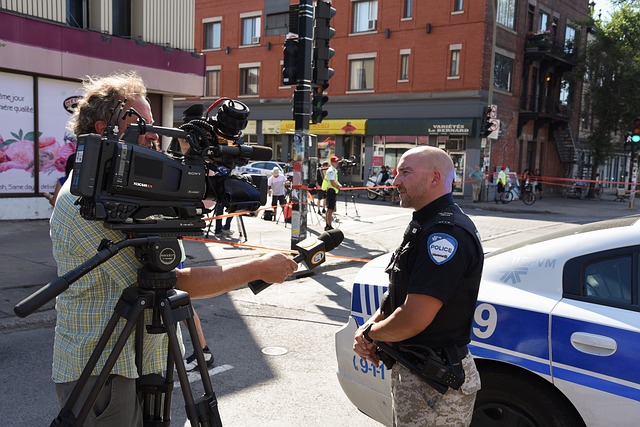 Police departments across the United States were tested to their limits during the political and social changes of the 1960s. They were often tasked to put down riots that often pitted the police force against the community. Local communities began to lose faith in the police, and it became the top priority for many police departments to restore their image as protectors of the community.
Police departments across the United States were tested to their limits during the political and social changes of the 1960s. They were often tasked to put down riots that often pitted the police force against the community. Local communities began to lose faith in the police, and it became the top priority for many police departments to restore their image as protectors of the community.
Community policing became the solution to restore the reputation of police forces across the nation. The 1980s saw a shift away from the “professional” police force that August Vollmer envisioned. Going back to the old decentralized model of predictable foot patrols allowed the police to begin rebuilding ties with the communities that they served once more. Criminology research proved that responding rapidly to a situation rarely deterred crime from happening. It increased the chances of catching a criminal in the act, but communities who held little to no respect for the police rarely reported crimes.
Under this new model of policing in communities, law enforcement became more reactive. They often went straight to the source of the problem, striking at hotspots that were known areas of criminal activity. Professionalizing the police force was an effort to make the police its own independent force. Now, community policing was an effort to make the police interdependent with the community. With this new model, the role of the police went beyond just providing security for the community. They became mediators, providers of emergency social service, and offered solutions for community improvements. These roles helped to create trust between the police force and the community once more.
Militarization
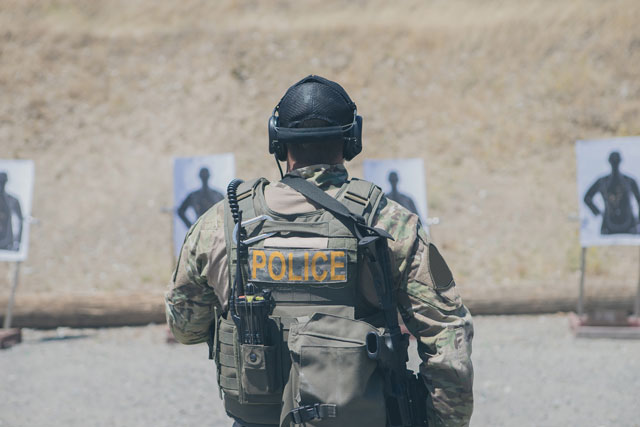 As more dangerous and modern weapons were introduced into communities across the United States, police officers were often equipped with military style weaponry. The movement towards arming themselves in such a manner was often pushed by the police officers themselves – the officers who had to respond to potentially deadly threats on a constant basis. During the formation of formal police forces in the 19th century, the topic of whether police officers should be armed with firearms was debated over fiercely.
As more dangerous and modern weapons were introduced into communities across the United States, police officers were often equipped with military style weaponry. The movement towards arming themselves in such a manner was often pushed by the police officers themselves – the officers who had to respond to potentially deadly threats on a constant basis. During the formation of formal police forces in the 19th century, the topic of whether police officers should be armed with firearms was debated over fiercely.
Many criminals in today’s world are well-equipped and well-funded. This has prompted modern day police forces to equip themselves to meet these threats. A precedent to this fact was during the prohibition era in which police officers squared off against gangsters armed with submachine guns. The FBI, as well as other law enforcement agencies, similarly armed themselves to counter the threat.
The riots that defined the 1950s and 1960s called for the police to respond in force – sometimes deploying thousands of officers to restore order. This era led to many police departments taking a more militaristic stance regarding weaponry and deployment. Los Angeles was the first city to introduce SWAT teams, a highly specialized unit that was armed with assault rifles, night vision goggles, advanced body armor, and trained in tactics used by the military.
The war on drugs waged by President Richard Nixon further prompted the militarization of the police force. During this time, police officers faced off with well-armed criminals who were funded by gangs and cartels that possessed millions of dollars due to the drug trade. During the War on Drugs, SWAT teams were heavily used in drug raids. Since that time in history, drug raids are primarily carried out by SWAT teams.
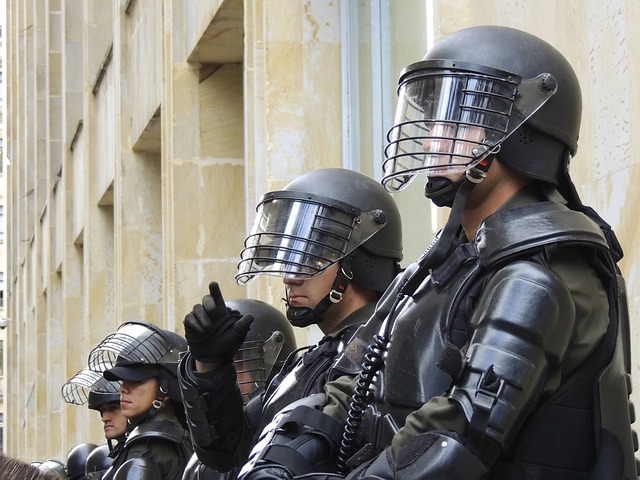 SWAT teams weren’t the only ones well equipped. Ordinary patrol officers have also been equipped with heavier weaponry to respond appropriately to heavily armed criminals. The 1997 bank robbery committed by Larry Phillips, Jr. and Emil Mătăsăreanu in North Hollywood found officers outgunned as they cornered the bank robbers outside of the bank during their escape. Armed with pistols and shotguns, the police officers were no match for the bank robbers who wore heavy body armor and carried military grade heavy assault rifles. Police officers found themselves commandeering heavier weapons from nearby gun stores to battle the threat. It finally took the intervention of SWAT officers to put an end to the situation. Miraculously, no officers were killed during the shootout despite robbers firing off well over 1100 rounds.
SWAT teams weren’t the only ones well equipped. Ordinary patrol officers have also been equipped with heavier weaponry to respond appropriately to heavily armed criminals. The 1997 bank robbery committed by Larry Phillips, Jr. and Emil Mătăsăreanu in North Hollywood found officers outgunned as they cornered the bank robbers outside of the bank during their escape. Armed with pistols and shotguns, the police officers were no match for the bank robbers who wore heavy body armor and carried military grade heavy assault rifles. Police officers found themselves commandeering heavier weapons from nearby gun stores to battle the threat. It finally took the intervention of SWAT officers to put an end to the situation. Miraculously, no officers were killed during the shootout despite robbers firing off well over 1100 rounds.
This incident lead to a series of reforms in which patrol officers in the LAPD were given heavier weaponry, such as M16 rifles and .45 ACP pistols. The North Hollywood event brought to the spotlight the need for officers to arm themselves appropriately to handle any situation that may come their way.
Overall, security and policing have come a long way. From the formation of night watchmen and slave patrols to motorized beat cops with military hardware, the United States police forces have undergone many dramatic changes. With threats of terrorist attacks and well-armed criminals on the rise, police departments have emphasized that they will continue to focus on officer safety in the field. As time progresses, it’s likely that security and policing in the United States will only continue to evolve to meet the threats that the United States faces every day.
References & Links
- The History of Security Guards
- The History of Policing in the United States
- The History of Policing In The West
- Early Policing In Colonial America
- Slave Patrols and Civil Servants
- Law Enforcement Facts: Important Facts In History
- Early History of Policing
- Police & Law Enforcement: History of Law Enforcement

